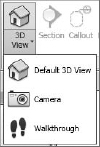Project Organization
If you're coming from a 2D CAD background, you're already familiar with a lot of terms and concepts that don't have exact corollaries in Revit. You're probably used to thinking in terms of what needs to be drawn and coordinated: plans, sections, elevations, details, schedules, and so on. You're also used to keeping that information in a lot of separate files that have to be linked together in order to reference other parts of the building. And you're used to being allowed to have only one person in one file at a time (which can be particularly frustrating from a workflow standpoint). And finally, maintaining all your project settings and management is a struggle across so many disconnected files.
Revit contains all these kinds of things. But at a high level Revit is about the four key components of a holistic and successful design process: relationships, repetition, representations, and restrictions. These concepts are respectively managed in Revit by data, content, views, and project management. And they are managed from within a single, bidirectional database.
Figure 2.1 shows what we like to think of as a Revit organization chart, which should give you a visual description of these four top-level categories and the kinds of things these categories contain. In the following sections, we'll discuss each of these categories and describe their particular role in your Revit project environment.
FIGURE 2.1 Revit organization chart

Datum
Datum consists of references, grids, and levels (Figure 2.2). The reason that datum is all about the relationships of your Revit project is because they establish and control your content (the building, stuff that goes in a building, and the stuff you need to document your building).

Reference planes can be created in any 2D view from the Home tab, but once created they may be visible in 3D. After you add reference planes to your project, they can be set and seen from the Work Plane panel. This will allow you to work with respect to the desired work plane.
Like reference planes, grid lines can be added to any 2D view. Keep in mind that grids may only be perpendicular to levels. Furthermore, grids are only visible in views that are aligned with the grid. So if the grid is in a North/South orientation, you'll only be able to see it in plan and from the North/South–oriented views.
Levels may be seen and created only in views that are parallel to the analytic ground plane in Revit. So you can't create levels in plan, and they can't be diagonal to the ground plane. To create any datum in Revit, simply select the desired type and then pick two points to define the start and end location.
CREATING AND DUPLICATING LEVELS
Creating a new level may or may not create a corresponding plan view (controlled by the Make Plan View option). Sketching a level defaults to creating a plan view. But copying an existing level will default to not creating a plan view, which is useful for creating relationships to content where no plan view is needed (for example, if you want to control multiple window elevations). The graphic indication of a level, which doesn't have a corresponding view, will be that the head of the level is black rather than blue.
![]() If you want to convert a datum level that doesn't have a view to one that does, select the Plan View option in the Create panel on the View tab. This opens the dialog box shown in Figure 2.3. You can select among all the non-view levels in your project and convert them to view corresponding levels.
If you want to convert a datum level that doesn't have a view to one that does, select the Plan View option in the Create panel on the View tab. This opens the dialog box shown in Figure 2.3. You can select among all the non-view levels in your project and convert them to view corresponding levels.
FIGURE 2.3 Converting datum level to view level
You can also use this option to create duplicate views of existing levels. Clear the option at the bottom of the dialog box (Figure 2.4) to see all the levels in your project.
FIGURE 2.4 All project-level datum

ANALYTIC AND GRAPHIC DATUM EXTENTS
We need to mention two important notes about the control and visibility of levels and grids. First, you can control both the graphic and analytic ends of levels and grids. If you control the analytic end of the grid, you're controlling the extents of the datum across the entire project and all views, and the 3D option will be visible as you pull the datum, as shown in Figure 2.5 (seen above Level 2).
FIGURE 2.5 Controlling the analytic extents of datum

If you only want to move the graphic extents of your datum, first click the 3D icon. Now you can graphically modify the datum but not the analytic extents (Figure 2.6).
FIGURE 2.6 Controlling the extents of datum

Second, datum can only be visible in a view that is being crossed by its analytical extents. Here's the difference. The elevation in Figure 2.6 shows lowering the ends of the grid above Level 2. This might be done to make an elevation graphically “cleaner” at a large scale.
In Figure 2.7, the analytic (3D) extents of the grid don't cross the levels. As a result, the grids would not be visible in those views.
FIGURE 2.7 Analytic (3D) datum extents
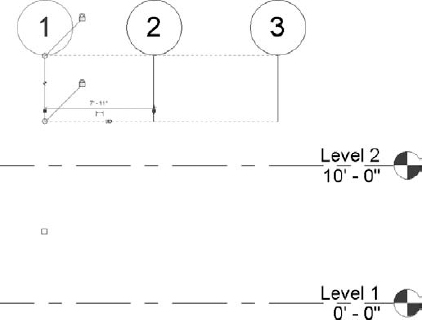
But in Figure 2.8, the analytic extents cross both Level 1 and Level 2 datum. But the graphic (2D) extents are above Level 2. This means that the grid datum would still be visible in both levels.
FIGURE 2.8 Graphic (2D) datum extents
When you move datum in Revit, one way or another content is going to respond. If you move a level, walls and furniture are going to move accordingly. If you move a grid, structural elements are going to relocate. And if you move references, the elements associated with them update. As a matter of fact, you'll often pin datum or lock dimensions in order to restrict movement of datum after your project is starting to develop.
In turn, content can have a relationship to other content. For example, content can be hosted or associated with other content. Walls host doors and windows. A wall can be “attached” to a roof above it (or a floor or even another wall below it). Tops and bottoms of walls can even be attached to the top or bottom of other walls. But did you know that walls can maintain relationships inside other walls?
Here's a simple exercise to understand these relationships between content:
- First, create a simple wall. Now let's edit the profile of the middle segment. Select the wall and click Edit Profile. Now you can't edit the middle wall's profile, as shown in Figure 2.9, until you select the Edit Profile option. Once you're in Edit Profile mode, simply delete all the boundary lines and then redraw them as shown.
FIGURE 2.9 Editing the wall's profile
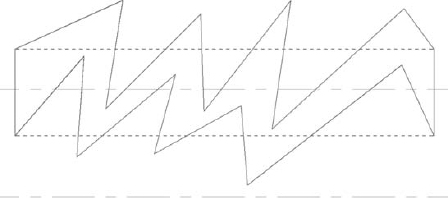
- Now finish Edit Profile mode. Then in a plan view, draw another wall directly on top of the one that you just created. Go ahead and use a different type that's wider than the first wall you used. Initially the walls will overlap and you'll get a warning, which is fine and can be ignored (Figure 2.10). In this case, the view is also set to Wireframe so you can see the edited wall's profile that's being enveloped by the second wall.
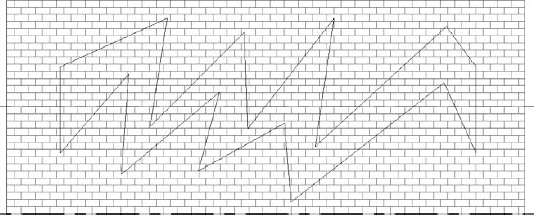
- Next comes the fun part. Using your Cut Geometry tool, cut the enveloped wall from the enveloping wall. Figure 2.11 shows the result.

- This builds a relationship between the wall that's being cut and the wall that's cutting. This relationship will be maintained even if you change the inner wall's profile or type. Change the wall to a Storefront Wall type, edit the elevation profile, and finish the sketch. The relationships are immediately updated (Figure 2.12).
So, objects in Revit are able to maintain relationships between other objects. But here's the thing—you may not always have associate geometry (like walls, floors, and roofs) to relate to other geometry. This is why datum is so important.
If you've been using Revit for a reasonable amount of time, it seems obvious that levels and grids would control content, but reference planes aren't often appreciated. Here's a simple exercise to demonstrate this special kind of relationship between reference planes and walls:
- Go to a plan view and create a series of concentric walls, as shown in Figure 2.13.

- Go to the front elevation view, as shown in Figure 2.14. If you move Level 1, you'll notice that the walls all move with it. You don't have to select the walls; it's in the properties of the walls to maintain a relationship to the Level 1 datum. You could make the top of the walls maintain this same kind of relationship to Level 2.
FIGURE 2.14 Datum and walls in context

- You can also create a relationship to the reference planes. To do so, simply select all the walls (just hover your mouse over one wall and then click and release the tab key to select the chain of walls) and then click the Attach Top/Base button. By default, Attach Wall
 Top is the default selection, so make sure that Attach Wall
Top is the default selection, so make sure that Attach Wall  Base is selected when attaching the base of walls to the lower reference plane.
Base is selected when attaching the base of walls to the lower reference plane.
Figure 2.15 shows the results in the elevation view, once you've attached the top and bottom of the walls to the upper and lower reference planes.

The incredible thing is that moving and rotating the attached reference planes can modify the attached relationships. This is shown in a perspective view of the walls in Figure 2.16.
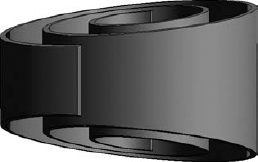
There are situations where you need a particular relationship to be maintained without attached relationships to geometry, but the top or bottom condition isn't a straight line. What to do? Well, here's another solution:
- First, copy all the walls from the previous exercise over to the side, as shown in Figure 2.17.

- Now select all the walls and attach their Top Constrain to Level 2, as shown in Figure 2.18.

What do you do when you want a curved or nonlinear attachment, and there's no geometry to attach to? You model an in-place void of the same category:
- Select Component
 Model In Place from the Home tab, Select the Walls category, and name the family Top of Wall Void. Now return to your Level 1 view and create a reference plan, as shown in Figure 2.19. Name the reference plan Top of Wall Void.
Model In Place from the Home tab, Select the Walls category, and name the family Top of Wall Void. Now return to your Level 1 view and create a reference plan, as shown in Figure 2.19. Name the reference plan Top of Wall Void.
FIGURE 2.19 Wall and reference plane

- Return to your South elevation, and you'll start to model the void that carves the top of the walls.
- When you start to create the revolve, you'll need to set the reference plane as shown in Figure 2.20. This will control the work plane with respect to the center of the series of tangent walls.
FIGURE 2.20 Setting the reference plan
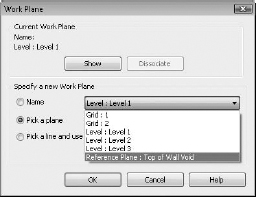
- Create the void revolve, as shown in Figure 2.21. To maintain relationships to Level 2, align and lock the top line to Level 2, and then dimension either side of the revolve sketch and lock those dimensions as well. Doing so forces the void to move up with Level 2. Since the walls are also constrained to Level 2, they will move up as well.
FIGURE 2.21 Revolving the sketch
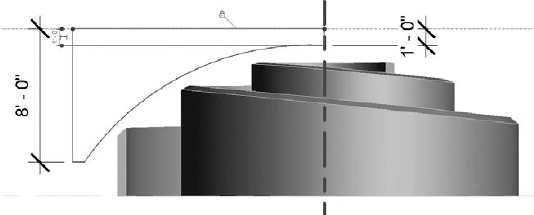
- Finish the sketch. Now you can use your Cut tool to remove the top of the walls from the in-place void (Figure 2.22).

When you finish the in-place family, the walls will look similar to Figure 2.23. If you move Level 2 up or down, the void and walls will maintain relationships to their datum.

Overall, it's the role of datum, levels, grids, and reference planes to create your project's key relationships.
Content
Content is all about repetition that you put in your Revit project to design, develop, and document your project. Content can often maintain relationships with other content, but more importantly, content maintains relationships to your project datum. As you can see from the Revit organization chart shown earlier in Figure 2.1, content includes system families, component families, and spaces.
System families (also called host families) are project content that is part of the Revit project environment. These families are not created in the Family Editor—they're already in your project environment. If you need another type, you'll duplicate an existing type from within the project. Content can be 2D or 3D. Walls, Floors, Roofs, Ceilings, Stairs, and Railings are common 3D system families. Text, Dimensions, Revision Bubbles, and Insulation are commonly used 2D system families.
Component families are created in the Family Editor and are also 2D or 3D content. This means that you'll have to create and load these kinds of families or files outside the Revit project environment. When you start to create a component family, you'll initially be given the dialog box in Figure 2.24. This is Revit prompting you to select the right family template. By selecting the right family template, you'll be certain that the component that you're creating is going to behave, view, schedule, and (if necessary) export properly.
FIGURE 2.24 Selecting a family template

The next category of content is spaces, such as rooms, areas, and volumes. Obviously this isn't the same thing as geometry. But they're also an important part of your project and maintain relationships to datum (as well as some system families). Like some system families, they're also phase, design option, and workset aware and can be scheduled.
Type and Instance Parameters
Everything in Revit has parameters, which are simply the information or data about something. The kind of information that you can assign to something is extensive (Figure 2.25).
FIGURE 2.25 Types of parameters

![]() There are two kinds of parameters: type and instance. The difference between the two kinds of parameters is important. Type parameters control information about every element of the same type. So, for example, if you change the material type of a piece of furniture, the material for all the furniture of that type will change. Instance parameters control only the instances that you have selected. So if the material of the piece of furniture that you've selected is an instance parameter, you'll only be editing the selected elements.
There are two kinds of parameters: type and instance. The difference between the two kinds of parameters is important. Type parameters control information about every element of the same type. So, for example, if you change the material type of a piece of furniture, the material for all the furniture of that type will change. Instance parameters control only the instances that you have selected. So if the material of the piece of furniture that you've selected is an instance parameter, you'll only be editing the selected elements.
Both instance and type parameters can be constantly exposed and docked in the Properties Pallet. Selecting something initially displays the instance parameters. Figure 2.26 shows the instance parameters of a wall that control the relative height, constraints, and structural usage.
FIGURE 2.26 Instance parameters of a wall

By clicking the Edit Type button, you expose the type parameters (Figure 2.27). These parameters control values such as the structure, graphics, and assembly code.
FIGURE 2.27 Type parameters of a wall
Views
Views are used to see the project. As you can see in the Revit organization chart shown earlier in Figure 2.1, there are both 2D and 3D views. Two-dimensional views are analytically oriented to specific coordinates, like plan, elevation, section, and so on. We've also grouped schedules under 2D areas of views. Views also have type and instance parameters (relative to each kind of view). Three-dimensional views are either orthographic or perspective in nature.
Understanding how to create and modify the properties of a view is important. First of all, every view has some kind of visibility parameters specific to that view (even schedules) that control what you want to be seen. Figure 2.28 shows the visibility parameters for an elevation. We'll discuss the other view properties when we describe the UI later in this chapter.
FIGURE 2.28 Visibility graphics

Creating and Duplicating Views
It's important that you understand how to create different view types and how to control their extents after they're created.
PLANS
When you create a corresponding level in elevation, you typically create plan views for your project. Figure 2.29 shows all of the level instance properties.
FIGURE 2.29 Plan view instance parameters
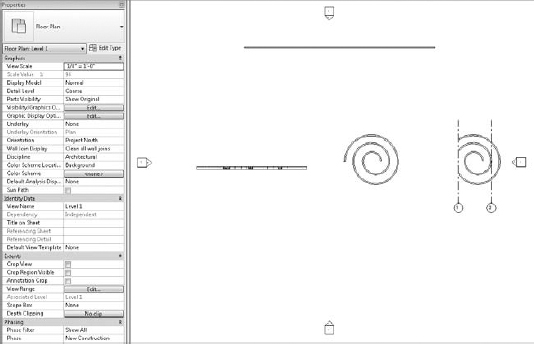
If you have a level without a corresponding view, you can also use the Plan Views function, as shown in Figure 2.30, to create a plan view.
FIGURE 2.30 Creating plan views

Next to the Plan Views option is the Duplicate View option, which allows you to duplicate the active view (Figure 2.31).
FIGURE 2.31 Duplicating existing views
You can also right-click a view name in the Project Brower and access the same option to duplicate the view (Figure 2.32).
![]() FIGURE 2.32 Duplicating views from the Project Browser
FIGURE 2.32 Duplicating views from the Project Browser

The vertical (in plan) and horizontal (in elevation) extents can also be controlled using view properties. The View Range settings, as shown in Figure 2.33, define the vertical range of the view.
FIGURE 2.33 View Range dialog box
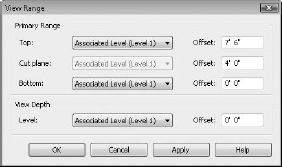
Checking the Crop Region Visible option can turn on the horizontal extents of a view. The shape may only be rectilinear (Figure 2.34).
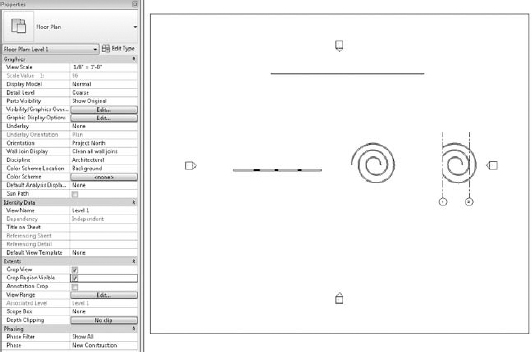
Although you can control the visibility of the crop region from this dialog box, we recommend that you keep it turned on since you can control the visibility when you print (Figure 2.35).
FIGURE 2.35 Hiding the crop when printing
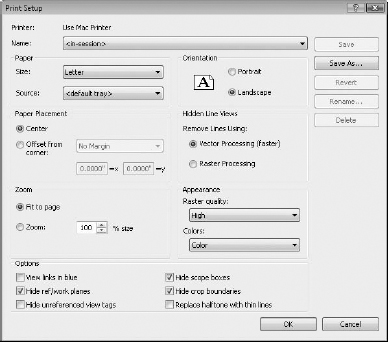
ELEVATIONS
Selecting the Elevation function on the View tab creates elevations. You'll also notice that as you place an elevation tag, they automatically orient to walls (Figure 2.36). If there's no host element nearby to reference, they'll automatically orient to the west.
FIGURE 2.36 Elevation tag orientation

Selecting the center of the tag will allow you to create additional elevation (more typically done for interior elevations) by selecting the unchecked boxes that surround the elevation tag (Figure 2.37).
FIGURE 2.37 Creating additional elevations

If you select the nose of the elevation tag, you'll see a blue line that defines the beginning of the cut plane for the elevation as well as a dashed line that defines the side and rear extents (Figure 2.38). This allows you to control the analytic extents of the elevation without moving the graphic tag, which is useful if you want the tag in a particular location but you want the actual elevation to start apart from the tag's location.

Finally, there are three types of elevations in Revit: exterior, interior, and framing. Their differences are more than graphic. Exterior elevations by default don't have an active crop boundary, only a starting cut plane. Interior elevations have their crop boundary on by default and attempt to find boundaries of host elements, like walls, floors, and ceilings. Framing elevations become active in the presence of grids, and their cut plane corresponds to their grid.
SECTIONS
Selecting the Section function on the View tab creates sections. By default, there are three types of sections: Building, Wall, and Callout Detail (Figure 2.39). This allows them to be grouped with better clarity in the Project Browser, but there are also other important properties.
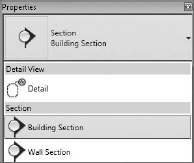
Unlike elevations, the cut plane of a section must correspond with the line of the section. Figure 2.40 shows the instance properties of a Building section. The far and side cut planes of a section can also be controlled. This goes for both Building and Wall sections.
FIGURE 2.40 Section properties and extents
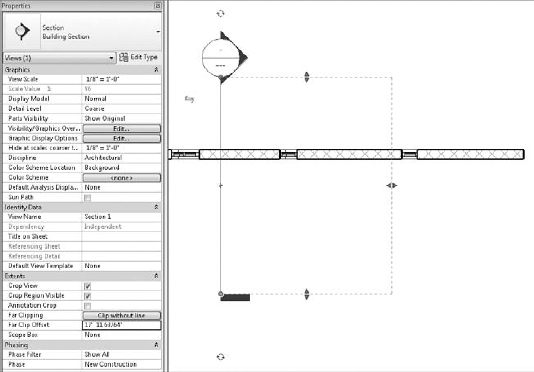
Neither Building nor Wall sections may be created in a nonperpendicular orientation with regard to project levels. But after you create them, they can be rotated in elevation. However, doing so would lead to confusion in your project because once rotated, the section wouldn't be available in plan.
This is where the Detail section is such a great help. A Detail section that's created in plan can not only be seen in corresponding views, but it will also presume different graphic conventions.
For example, take a look at the two Detail sections in Figure 2.41 that are to the right of the Building section. When you create a Detail section, it will look like Detail Section 1. But when you view it in referring views, it will look like Detail Section 2.
FIGURE 2.41 Detail sections in plan view

![]() The other thing that you should note is the color of callout and selection heads in Figure 2.41. These “blue” icons act as hyperlinks to the other views in your project. The great thing about them is they are automatically coordinated numerically when you place the views on your document set.
The other thing that you should note is the color of callout and selection heads in Figure 2.41. These “blue” icons act as hyperlinks to the other views in your project. The great thing about them is they are automatically coordinated numerically when you place the views on your document set.
If you go to the view of the Building section, you see that the Detail sections are graphically the opposite of what you've seen in plan view (Figure 2.42).
FIGURE 2.42 Detail sections in section view

CALLOUTS
There are two types of callouts: Detail and Floor Plan (Figure 2.43). Although Detail callouts may look like Detail sections graphically, they're not visible inside other perpendicular views. So a callout created in plan view will not be visible in elevations or sections like a Detail section.

It's probably best to think of a Detail callout as an enlarged view. Its Far Clip settings are by default the same as the parent view (Figure 2.44).

![]() You can think of a Floor Plan callout as another plan view but with associated callout graphics. Floor Plan callouts also have all the same view controls as a regular plan view, such as Depth Clipping and View Range (Figure 2.45). Take a moment to note the line and control arrows around the border of the view. By modifying the location of these arrows, you're modifying the extents of the view. Of course, more than plan views can have their extents modified; elevations, sections, and callouts can all have their view extents modified in the same way.
You can think of a Floor Plan callout as another plan view but with associated callout graphics. Floor Plan callouts also have all the same view controls as a regular plan view, such as Depth Clipping and View Range (Figure 2.45). Take a moment to note the line and control arrows around the border of the view. By modifying the location of these arrows, you're modifying the extents of the view. Of course, more than plan views can have their extents modified; elevations, sections, and callouts can all have their view extents modified in the same way.
FIGURE 2.45 Floor Plan callout
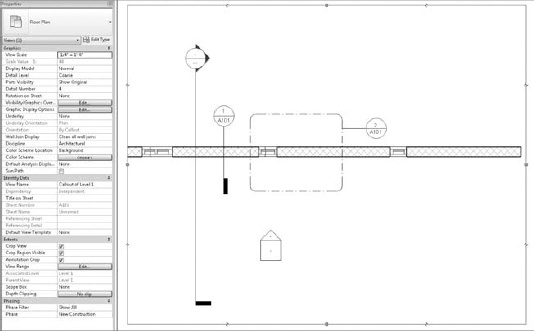
DRAFTING VIEWS
Drafting views give you the ability to draw without first creating a reference to something in your project. They may contain Detail and Repeating Detail components, as well as all the annotation and documentation tools that Revit has to offer. Drafting views are great for drafting standard or analytic conditions that don't require an actual geometric underlay.
Once you've created a drafting view, you can refer to this view when creating an elevation, section, detail, and so on that would normally rely on an actual view of the model. As you start to create a standard project view (Figure 2.46), simply select the Reference Other View option and then you'll be allowed to select a reference view from all the other like views in your project, as well as any drafting views.
FIGURE 2.46 Drafting view reference

LEGENDS
There are two types of legends: legends and keynote legends. Regular legends are used to assemble analytic views of content in your project, graphics, geometry, tags, and so on—anything that lives in your project. Legends may contain Detail, Repeating Detail, and Legend components (Figure 2.47).

A Legend component (Figure 2.48) is a special bidirectionally associative representation of 3D system and component families that may only appear in legend views (not drafting views). If you make a change to an element in your project, the representation of that element in the legend will change as well.
Keynote legends are special schedules. When creating a keynote legend, you'll be prompted much the same way as you are when creating a schedule (Figure 2.49).
FIGURE 2.49 Creating keynote legends

SCHEDULES
There are five types of schedules in Revit: Schedule/Quantities, Material Takeoff, Sheet List, Note Block, and View List (Figure 2.50).

Schedules/Quantities in Revit are used to quantify the actual building elements that are being used in the project, not the elements that are loaded in the project (Figure 2.51).
FIGURE 2.51 Creating a schedule

Three categories of elements may be scheduled via Schedules/Quantities:
- Masses: Mass and Mass Floors
- Spaces: Rooms and Areas
- Content: System and Component Families
There is also a special schedule called a Multi-Category schedule. It is used to create and master schedule component families (and may only contain component families) across many categories.
We think that being able to create a Multi-Category schedule that could contain everything in one place would be great, as it would allow you to see your entire project in one schedule. We hope this is being planned for the future.
DOCUMENTATION
Sheets in Revit ultimately contain all the documentation for your project and come in a variety of standard as well as custom sizes. The important thing to remember is that you're not going to select a “scale” when you print a sheet; it's really more like printing than “plotting.” If you need your sheet to be smaller or fit on the desired page, these options are available and using them is little different than printing from a word processing application.
3D VIEWS
There are two kinds of 3D views in Revit: orthographic and perspective. Three-dimensional views are orthographic, and Camera and Walkthrough views are in perspective. You can't change one to another after the fact, so select carefully (Figure 2.52). We'll also cover 3D views in more detail in Chapter 12, “Visualization.”
Orthographic views will always show parallel edges along Cartesian X, Y, and Z axes. Orthographic views are best if you need to show model information to scale. A lot of people don't realize that it's possible to dimension and detail in Revit from a 3D orthographic view.
After isolating the part of the model that you want to dimension, the trick is to set the appropriate work plane (Figure 2.53) before dimensioning.
FIGURE 2.53 Setting the work plane
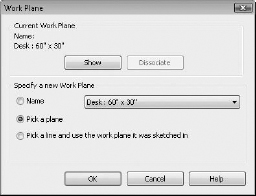
As long as you're careful about setting the work plane as you work, you can add dimensions and text to your views, as shown in Figure 2.54.
FIGURE 2.54 Dimensions in 3D orthographic views
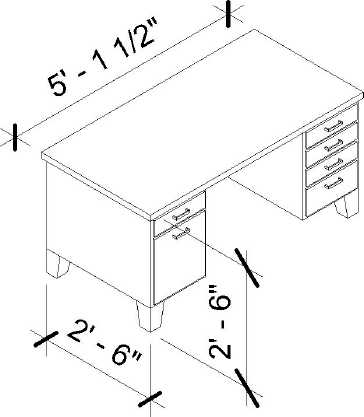
Create perspective views by placing the start and end points of a camera (typically from a plan view). It should be noted that the first point you select in plan is where the view will be taken from, but the second point is also the rotation origin for the view (Figure 2.55). This is important because if you select a second point that is far beyond your view, when you open the view and attempt to modify it, it will rotate around a target that doesn't seem to make sense. That's because the target location of the view is off in the distance.
FIGURE 2.55 Setting eye and target origin

A perspective view will not be to scale, but it can be made relatively larger or smaller by selecting the view's boundary and then selecting the size crop from the Modify | Camera tab (Figure 2.56). Once you do this, you'll have the option to change the view size and field of view (proportionally or nonproportionally). You can also simply drag the nodes of the bounding box.
FIGURE 2.56 Modifying the view size and field of view

Camera extents are defined by the Far Clip Offset option, accessed in the View Properties dialog box's View Extents settings (Figure 2.57).

If the Far Clip Offset is too shallow, the view will look something that Figure 2.58. Geometry that you'd expect to see will be “clipped” in the view.
FIGURE 2.58 Far Clip Offset is too shallow.
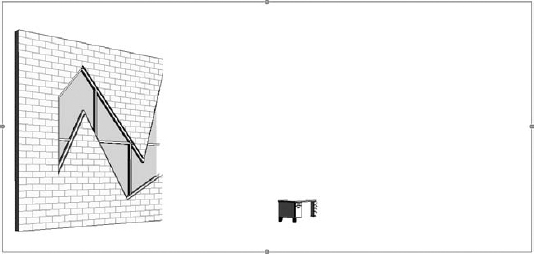
Simply increase the Far Clip Offset value to show more of the model. You may also do this graphically by returning to a plan view, right-clicking the view, and selecting Show Camera (Figure 2.59).
FIGURE 2.59 Selecting Show Camera

Once the camera is shown in your plan view, you can select the node at the far end of your clipping plane and manually drag the node to extend the Far Clip Offset of your view (Figure 2.60).
FIGURE 2.60 Extending the Far Clip Offset
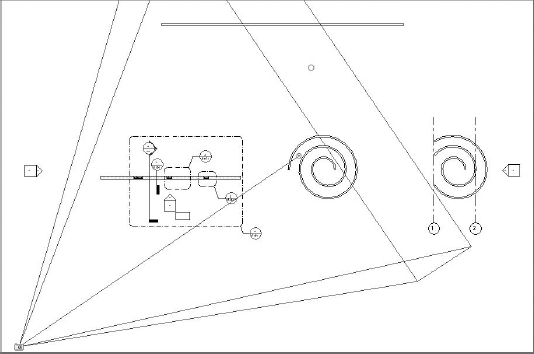
Finally, 3D views (even walkthroughs) contain section boxes, which become active when selecting the Section Box option (Figure 2.61). This will allow you to control how much of the project is shown and is helpful for creating cutaway visualizations in real time or in renderings.

Management
Project management involves all the project settings that control (and therefore restrict) any number of project variables. Looking at the Revit organization chart in Figure 2.1, we'll examine each of the management options in the rest of this chapter as we explore the UI. At the moment, the most important part of project organization to discuss is worksets, because this topic involves workflow and how the team comes together to work on the project simultaneously. Worksharing is covered in more detail in Chapter 6, “Understanding Worksharing,” but we'll cover this topic here at a high level as it relates to overall workflow of Revit.
There are two kinds of worksets: system managed and user managed. The user cannot create, manage, or assign system-managed worksets. Users can only create, manage, and assign worksets and elements that are assigned to user-created worksets (Figure 2.62).
FIGURE 2.62 Only user-created worksets are visible by default.

When worksharing is enabled, Revit creates worksets for everything in the project: datum, content, views, and settings. Revit manages the worksets related to families, views, and project standards.
But as for the actual content that is being used in your project (not just loaded, but actually in use), such as datum, 3D host and system families, and spaces, Revit allows you to create, manage, and assign worksets to those elements. The elements that are assigned to user-defined worksets are illustrated in Figure 2.63.
FIGURE 2.63 Elements assigned to user-defined worksets
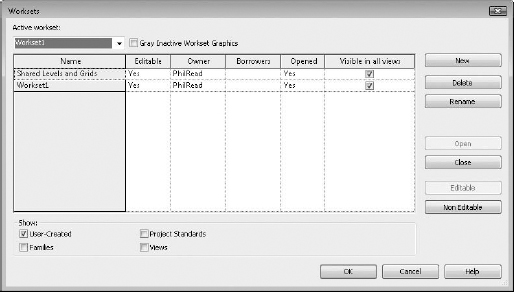
Levels and grids are assigned to the Shared Levels And Grids workset. All other 3D project geometry (system or components) is assigned to Workset1.
The great thing is that you only need to create and assign worksets to a limited number of objects that you're using in your project. Revit is managing the worksets assigned to everything else.
If you want to review any of the content from this portion of the chapter, you can download the c02_Organization.rvt file from the Chapter 2 folder. This file will allow you to investigate the complex 3D forms that were created using reference planes, hosted relationships, edited elevation profiles, and more.







